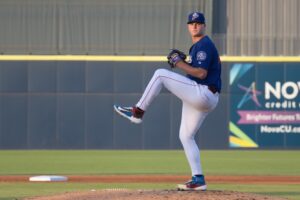Sad about Jake Burger? Read this and continue to be sad
It’s apparent that Jake Burger was not sufficiently dunked in the River Styx as a child, as we learn of his second tear of his Achilles tendon, completely resetting his rehab and starting the recovery clock at twelve months… again.
This is upsetting for obvious reasons! Burger will be 23 before he even steps on a field again, with only 51 professional games under his belt so far. 47 of those were with the low-A Kannapolis Intimidators last season, where he hit .271/.335/.409, fresh off being drafted 11th overall. Prior to the first tear, which happened during an early Spring Training Game, he was a Top 10 Sox prospect (#8 on the FutureSox list).
You can read more about the situation in Brian Bilek’s post here. While Rick Hahn assures us that this is fine, actually, it’s hard to believe – how does a 21/22-year-old tear his Achilles twice? How will this affect him both at third base and at the plate? A huge part of his draft value was that he was a third baseman who had power. Are either of those things still true? It’s a very White Sox turn of events, and like most torturous things with uncertain outcomes, it will take some time to get to any answers.
One thing we can do – as we so often do on Thursdays here are FutureSox Dot Com – is look at the past. Past… Sox. There is a diagonal precedent here. Not the same exact injury (but in the same general location), and a very different player profile (which should make everyone feel better), but in recent White Sox prospect history there was a 21-year-old, highly-regarded first-round draft pick who tore the posterior tibial tendon in his ankle while making an admittedly spectacular catch and was faced with an uncertain future.

It’s true that Jared Mitchell was built for speed, as opposed to Burger’s power profile. It’s true that Jared Mitchell was an outfielder, not a corner infielder. It’s also true that Jared Mitchell had exactly one decent half-season in his six partial seasons in affiliated ball after the injury, and it’s true that he’s back for his third season of indy ball in 2018. He signed a minor league deal with the Reds at the end of 2017 (I witnessed him with my own eyeballs in a Reds uniform this spring) but was released at the end of Spring Training and re-signed with his old team, the York Revolution.
I know this is a comparison of Jared Mitchell and Jake Burger, but before I go any further I do want to say again that they are different types of players with different type of injuries that inherently come with different recovery strategies and timeframes. This is probably the closest comparison within the system we have. Jose Contreras did tear his Achilles in 2008 and recovered shockingly quickly, even having some not-irredeemably-terrible seasons afterwards before his retirement, although a) he’s a pitcher and b) he was only expected to miss nine months after surgery, which makes it seem possible that his tear was not as bad. Maybe it was and Jose Contreras is magic and the Burgatron will follow a similar recovery path, but we don’t go for optimism here on Thursdays.
Jared Mitchell, drafted 23rd overall in 2009, had surgery to repair the torn ankle tendon on March 16, 2010. His prognosis was good; he was expected to make a full recovery and to not be affected by the injury in the future. At the time, Mitchell had just one partial season under his belt, 34 games with Kannapolis, in which he hit .296/.417/.435. It was a promising start, and his eye at the plate wasn’t bad either, with 23 walks and 40 strikeouts. The power wasn’t necessarily there, but the speed was, and he hit 12 doubles and two homers to accompany five stolen bases (and three caught stealing). A solid first year.
He returned to game action with the Arizona Fall League in October of that year, about six months later and a little ahead of schedule. He did not perform well, with a deeply-sub-.200 batting average that can probably be attributed to not playing baseball all year, then suddenly playing baseball with top prospects who had been playing all year.

But the struggles continued, perhaps amplified by a baffling promotion to the double-A Barons and an equally baffling call-up to the triple-A Charlotte Knights, both in 2012. In 90 games between the two levels in an injury-hampered 2013, Mitchell again failed to reach .200, again by a large margin. He had a resurgence in 2014, the best year he would ever have – with the Barons, he hit .299/.367/.561 in 39 games, hitting 10 home runs. The struggles returned with another promotion to the Knights, though, and he hit .230 and struck out 111 times in 81 games.
Mitchell was released in 2015, six years after his selection in the first round of the draft. He spent time in the Angels and Yankees systems before going to the independent York Revolution, where, as mentioned, he remains today.
Did Mitchell not put it all together because of the injury, or was he just not ever going to be that good? It’s impossible to say without the use of time travel, and obviously future time travelers don’t care that much about the White Sox because they pretty clearly failed to materialize at the crisis moment. These questions don’t have an answer and it makes them exasperating. What would have happened if Mickey Mantle hadn’t tripped on a pipe in the outfield or whatever? Impossible to say. There’s no control group here. Mitchell might have been an All-Star, or this could have all happened anyway. It’s not his fault – it’s obvious that he’s been putting in the work and has, I’m sure, agonized over the question more than even the most devoted Sox fan. I hope he gets another shot somewhere.
So what’s going to happen with Burger? Nobody knows. Nobody can say what his career trajectory would have been before the first tear, absolutely nobody can say what it’s going to be now after the second. Hahn is optimistic, but that’s his job; they were optimistic about Mitchell as well. The question here is less work ethic and natural ability and more physical limitations and freak quirks of the human body. It’s not hard to imagine that psychological effects will play a role, it’s not hard to imagine that the slightest tweak in a ballplayer’s body will throw them off, let alone the complete tear of a major tendon. It’s also not really that hard to imagine that he’ll come back better than ever – maybe with more awareness of his body, a better knowledge of what it can do and what kind of Baseball Feats it can produce. Players sometimes see improved results just by tweaking their stance a millimeter; who knows what could happen here?
Honestly, speculation is just an exercise in pointlessness. He’ll come back or he won’t. He’ll fulfill his original potential or he won’t (and either way, we’ll never know). All we can do as fans is support his recovery, keep track of updates, and start or continue to develop an ultra-powerful, nigh-unbreakable artificial tendon made out of, I don’t know, zip ties or something.
Want to know right away when we publish a new article? Type your email address in the box on the right-side bar (or at the bottom, if on a mobile device) and click the “create subscription” button. Our list is completely spam free, and you can opt out at any time.



